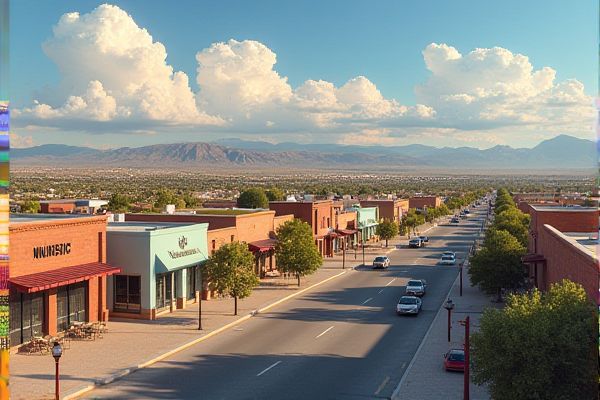
Insights from New Mexico residents and expatriate communities: Climate and weather patterns. Cost of living variations. Local cuisine and food culture. Popular outdoor activities. Cultural events and festivals. Housing market trends. Healthcare facilities access. Transportation and commute options. Educational institutions quality. Wildlife and natural conservation efforts.
Climate and weather patterns
New Mexico residents are experiencing a climate that is getting hotter and drier, with earlier springs, hotter summers, and less predictable winters, leading to increased droughts and reduced water availability. These changes are resulting in more extreme heat and wildfires, which are straining resources and impacting daily life, agriculture, and Natural Resources. The challenges posed by these climate conditions are significant and demand urgent attention to ensure sustainable living in the region.
Cost of living variations
The cost of living in New Mexico varies significantly depending on the location, with the state average being 5% lower than the national average. Cities like Las Cruces and Carlsbad have a 10% lower cost of living compared to the national average, while Albuquerque is 6% lower, and Los Alamos is 3% higher. For more detailed information on these comparisons, visit the Cost of Living Calculator to explore specific statistics and figures for different cities in New Mexico.
Local cuisine and food culture
New Mexican cuisine is a rich fusion of Spanish, Native American, and Mexican influences, with chile peppers being a central ingredient. The culture is deeply embedded in the state's history and daily life, reflected in dishes like green and red chile sauces, combination plates, and traditional foods like posole and biscochitos. For more insights into the unique culinary landscape and vibrant flavors of New Mexico, be sure to explore the offerings at Visit Albuquerque, where you can dive deeper into the history and tradition behind these beloved dishes.
Popular outdoor activities
New Mexico residents and expatriate communities enjoy a wide range of outdoor activities, including fly fishing, hiking, camping, kayaking, canoeing, skiing, hunting, and whitewater rafting, with many opportunities available in the state's numerous state and national parks, and along its scenic rivers and mountains. Residents and visitors alike participate in activities such as whitewater rafting, kayaking, stand-up paddle boarding, and wilderness travel, particularly in the Santa Fe and Taos areas, which offer diverse river trips and land-based adventures. The region offers hiking, biking, wildlife viewing, fishing, skiing, horseback riding, and hunting, with popular spots like Jemez Springs, Petroglyph National Monument, and the Rio Grande Nature Center State Park, catering to a variety of interests and skill levels. In Santa Fe, outdoor enthusiasts can enjoy hiking, biking, skiing, river rafting, fishing, golfing, and equestrian activities, with the city's proximity to the Sangre de Cristo Mountains and its numerous trails and scenic landscapes making it a hiker's and nature lover's paradise.
Cultural events and festivals
New Mexico residents and expatriate communities celebrate a rich cultural calendar, highlighted by events like the Albuquerque International Balloon Fiesta, the Santa Fe Indian Market, Las Fiestas de Santa Fe, and the Traditional Spanish Market, which showcase the state's unique blend of Native American and Hispanic heritage through art, dance, food, and traditional festivities. These events reflect the state's deep cultural roots and vibrant community spirit. For more details on these celebrations, visit the New Mexico Planning a Trip: Calendar of Events page.
Housing market trends
The New Mexico housing market is characterized by a median home sales price of $389,300 as of October 2024, marking a 6.1% increase from the previous year. Homes are typically staying on the market for 53 days, pointing to a less competitive but still seller-favored market. This trend is largely due to higher mortgage rates and moderate inventory levels. For detailed insights into these dynamics, explore the latest analysis on the New Mexico Housing Market available on Bankrate.
Healthcare facilities access
In New Mexico, the Health Care Delivery and Access Act is a pivotal initiative designed to enhance healthcare access, especially in rural regions, by setting up a Medicaid Directed Payment Program. This program successfully secures $1.3 billion in federal funds for hospitals, guaranteeing long-term financial stability and the continuation of healthcare services. Meanwhile, for expatriate communities in Mexico, Lakeside Medical Group provides a comprehensive managed care model that includes free membership, minimal copayments, and supports more than 350 American and Canadian insurance plans, thus offering accessible and high-quality services specifically tailored to the needs of expats.
Transportation and commute options
New Mexico offers a diverse range of public transportation options, including the Rail Runner Express, ABQ Ride, Santa Fe Trails, and various regional transit systems, providing both free and fee-based services to cater to different communities and needs across the state. These services include bus routes, dial-a-ride services, and commuter options, ensuring accessibility and convenience for residents and visitors alike. For more detailed information about these services, you can visit the official New Mexico Public Transportation website.
Educational institutions quality
New Mexico residents recognize the need for significant improvements in the education system, with only a small percentage rating it as "excellent" or "good." The state's educational challenges are exacerbated by poverty and marginalization, highlighting the necessity for a system that addresses these barriers and focuses on meaningful learning, skilled educators, integrated student supports, high-quality [early learning](https://learningpolicyinstitute.org/product/new-mexico-improving-education-report), and equitable funding.
Wildlife and natural conservation efforts
New Mexico residents and expatriate communities are advocating for modernized wildlife management through Senate Bill 312, the New Mexico Wildlife Heritage Act, which aims to update the state's wildlife conservation practices, expand the department's mission, and address critical conservation needs amidst growing environmental threats. The bill includes provisions to manage both game and non-game species, prevent wildlife waste, and allocate funding for priority species conservation. To learn more about this initiative and its impact, visit the Southwest Audubon website for detailed information and action steps.
